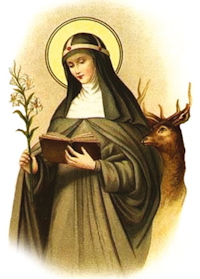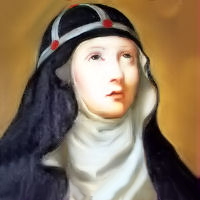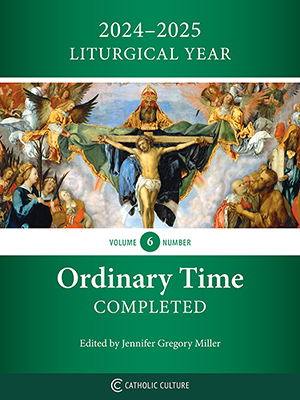Lent: March 24th
Monday of the Third Week of Lent
Other Commemorations: St. Catherine of Sweden, Virgin (RM)
» Enjoy our Liturgical Seasons series of e-books!
The Liturgy today is concerned with Baptism. Water by itself cannot cleanse leprosy; but God can use it to do so. If God can cleanse the leprosy of the body with water there is no reason why he cannot use it to wash leprosy of soul. The second point which the Liturgy intends to bring home to us is that God’s salvation is offered and available to all men who believe in his words and obey them. —St. Andrew Bible Missal
The Roman Martyrology commemorates St. Catherine of Sweden (1331-1381), the fourth child of St. Bridget of Sweden. She married at the age of fourteen with a mutual vow of chastity. After being widowed, she remained as her mother's constant companion in Rome for 25 years. When St. Bridget died, Catherine returned to Sweden and became superior of the Brigittine Order, and served as abbess until her death.
Meditation for Monday of the Third Week of Lent—Baptized in Christ
Baptism is a key word in Lent. As we know, its institution was as a period of intense preparation for baptism at the Easter Vigil, and ideally it still has this slant. Baptism is never over and done with. Baptism is a state—it must always continue. We have been put into a state of Baptism and we must live out the truth of that state.
What does it mean to be baptized? Various answers will come to mind, but if the answers are authentic they will reflect different aspects of the basic truth. Baptism is ultimately the sacrament of the Fatherhood of God, by it we become His sons and daughters, which is what humanhood is all about.
How is this metamorphosis of becoming a child of God effected? By dying to our purely natural life and being born again into new life, spiritual life, the life of the Risen Christ which is the life of God Himself.
How is this metamorphosis of becoming a child of God effected? By dying to our purely natural life and being born again into new life, spiritual life, the life of the Risen Christ which is the life of God Himself.
Baptism takes us up into the movement of Jesus, “I go to the Father.” We know the incredible pain, grief, darkness of that journey which we call the passion and death of Jesus. Basically it is our journey through the sadness and darkness sin or estrangement from God has caused. It is because our only way to the Father lies through death that Jesus died. He transformed that dark passage. Now it is truly a pathway of light leading straight to the Father.
We are summoned to faith. Summoned to deny, move off our own base and to stand on God’s fidelity as revealed in Jesus. We are summoned to accept His judgements, His values, His point of view; to surrender to His will, His guidance. The opposite of sin is not virtue but faith. Faith destroys sin as light destroys darkness.
To be baptized, to live in the state of baptism is to live in and by faith: not just to make acts of faith now and then but to live our lives by faith—absolute trust in the forgiving, self-donating God.
What we tend to do is live faith in fits and starts, acknowledging Him in some areas, denying Him in others. Baptism only becomes total when faith is total. Then truly we have died with Christ to a purely human life, and risen to His divine way of being.
There can be no realism in our living unless we keep our eyes on the blessed passion of Christ, and Lent is the time when the Church bids us accept the pain of having this sacred passion always before our eyes. In the passion we measure the greatness of His love, the seriousness of our lives with their countless choices, the certitudes upon which we base ourselves.
Lent is the time of effort, warfare, discipline. Let us look and look again at the suffering Jesus and take the weight of shame and sorrow.
It is often said, and rightly, that we cannot contemplate the death and resurrection of Jesus save in the radiance of the resurrection. But because of what we are, there is a need that, at a particular time of year we should, as it were, step out of this radiance and stand in the unredeemed dark—looking at what our sins have done, looking at what our redemption cost the Lord.
“You who have been baptized in Christ are clothed head to foot in Christ.” Let us accept the shame of the necessary stripping so that we may indeed rise anew at Easter, clothed in the glory of the risen Jesus.
—Ruth Burrows, Through Him, With Him, In Him

Monday of the Third Week of Lent
Station with San Marco al Campidoglio (St. Mark at the Capitol):
The Station is in the church of St. Mark, the full official name San Marco Evangelista in Campidoglio, St Mark the Evangelist at the Capitol, which was built in the fourth century in honor of the evangelist, by the holy Pope Mark, whose relics are kept there. This was the one of the oldest churches constructed. The church has undergone several reconstructions and restorations, including a heavy Baroque restoration.
For more on San Marco al Campidoglio, see:
- Churches of Rome
- The Station Churches
- Rome Art Lover
- Roman Churches
- PNAC
- Aleteia
- Station Church
- The Catholic Traveler
For further information on the Station Churches, see The Stational Church.
St. Catherine of Sweden
Catherine of Sweden, Saint, the fourth child of Saint Bridget of Sweden (q.v.) and her husband, Ulf Gudmarsson, b. 1331 or 1332; d. March 24, 1381. At the time of her death St. Catherine was head of the convent of Wadstena, founded by her mother; hence the name, Catherine Vastanensis, by which she is occasionally called. At the age of seven she was sent to the abbess of the convent of Riseberg to be educated and soon showed, like her mother, a desire for a life of self-mortification and devotion to spiritual things. At the command of her father, when about thirteen or fourteen years old, she married a noble of German descent, Eggart von Kürnen. She at once persuaded her husband, who was a very religious man, to join her in a vow of chastity. Both lived in a state of virginity and devoted themselves to the exercise of Christian perfection and active charity. In spite of her deep love for her husband, Catherine accompanied her mother to Rome, where St. Bridget went in 1349.
 Soon after her arrival in that city Catherine received news of the death of her husband in Sweden. She now lived constantly with her mother, took an active part in St. Bridget's fruitful labors, and zealously imitated her mother's ascetic life. Although the distinguished and beautiful young widow was surrounded by suitors, she steadily refused all offers of marriage. In 1372 St. Catherine and her brother, Birger, accompanied their mother on a pilgrimage to the Holy Land; after their return to Rome St. Catherine was with her mother in the latter's last illness and death.
Soon after her arrival in that city Catherine received news of the death of her husband in Sweden. She now lived constantly with her mother, took an active part in St. Bridget's fruitful labors, and zealously imitated her mother's ascetic life. Although the distinguished and beautiful young widow was surrounded by suitors, she steadily refused all offers of marriage. In 1372 St. Catherine and her brother, Birger, accompanied their mother on a pilgrimage to the Holy Land; after their return to Rome St. Catherine was with her mother in the latter's last illness and death.
In 1374, in obedience to St. Bridget's wish, Catherine brought back her mother's body to Sweden for burial at Wadstena, of which foundation she now became the head. It was the mother-house of the Brigittine Order, also called the Order of St. Savior. Catherine managed the convent with great skill and made the life there one in harmony with the principles laid down by its founder. The following year she went again to Rome in order to promote the canonization of St. Bridget, and to obtain a new papal confirmation of the order. She secured another confirmation both from Gregory XI (1377) and from Urban VI (1379), but was unable to gain at the time the canonization of her mother, as the confusion caused by the Schism delayed the process. When this sorrowful division appeared she showed herself, like St. Catherine of Siena, a steadfast adherent of the party of the Roman Pope, Urban VI, in whose favor she testified before a judicial commission. Catherine stayed five years in Italy and then returned home, bearing a special letter of commendation from the pope. Not long after her arrival in Sweden she was taken ill and died. In 1484 Innocent VIII gave permission for her veneration as a saint and her feast was assigned to March 22 in the Roman Martyrology. Catherine wrote a devotional work entitled "Consolation of the Soul" (Sielinna Troest), largely composed of citations from the Scriptures and from early religious books; no copy is known to exist. Generally she is represented with a hind at her side, which is said to have come to her aid when unchaste youths sought to ensnare her.
—Excerpted from The Catholic Encyclopedia, J.P. Kirsch
Patronage: Vadstena, Sweden; against abortion; for healing and protection from miscarriage
Symbols and Representations: Brigittine abbess with a hind at her side; Brigittine holding a lily; Brigittine dressing a poor man’s wounds; Brigittine being brought Communion on her death bed.
Highlights and Things to Do:
- Read more about St. Catherine of Sweden:
- Visit the Brigidine Sisters website and read about St. Catherine.






